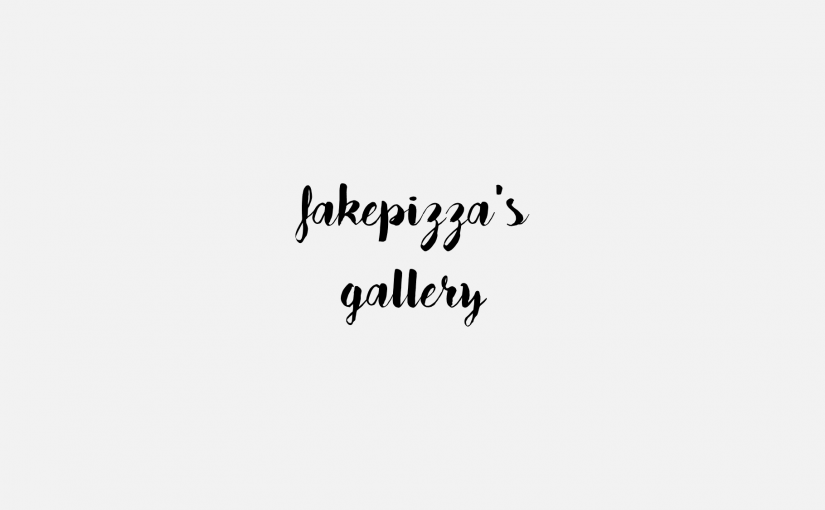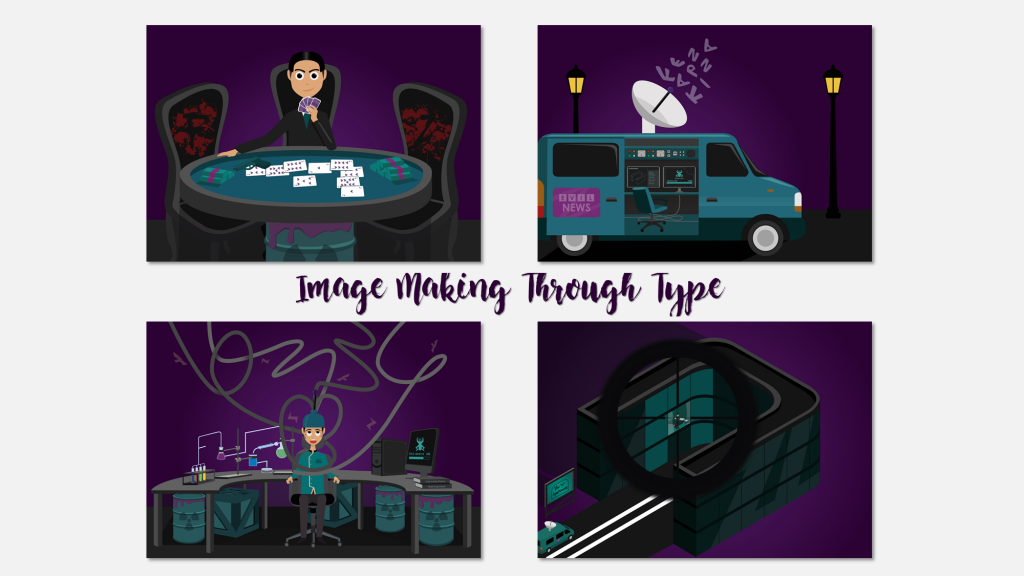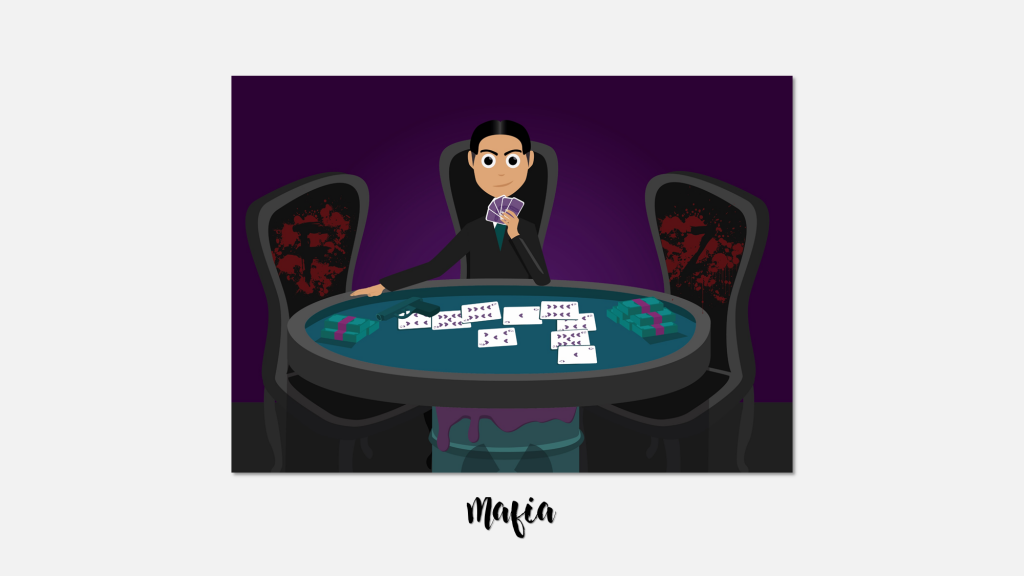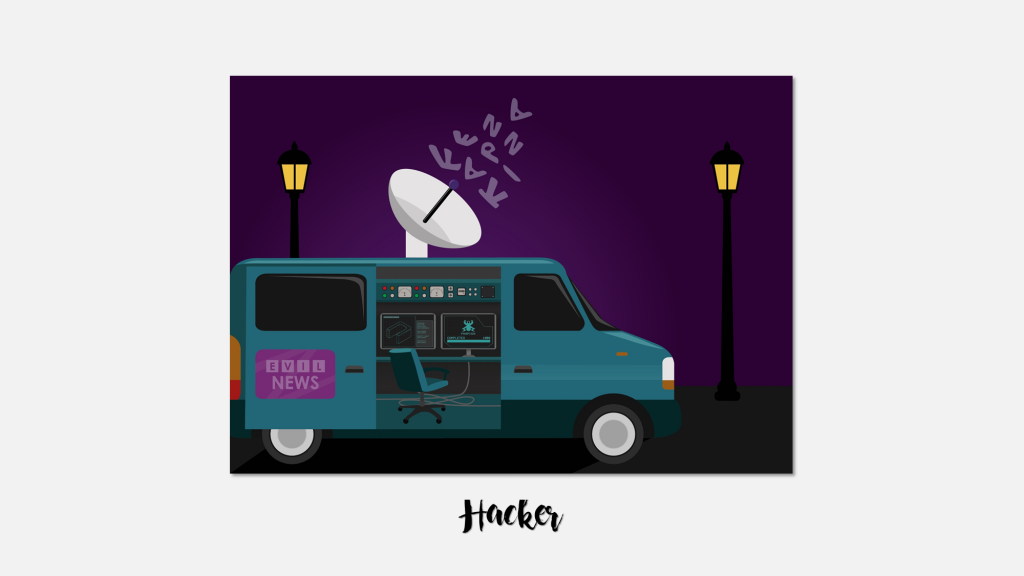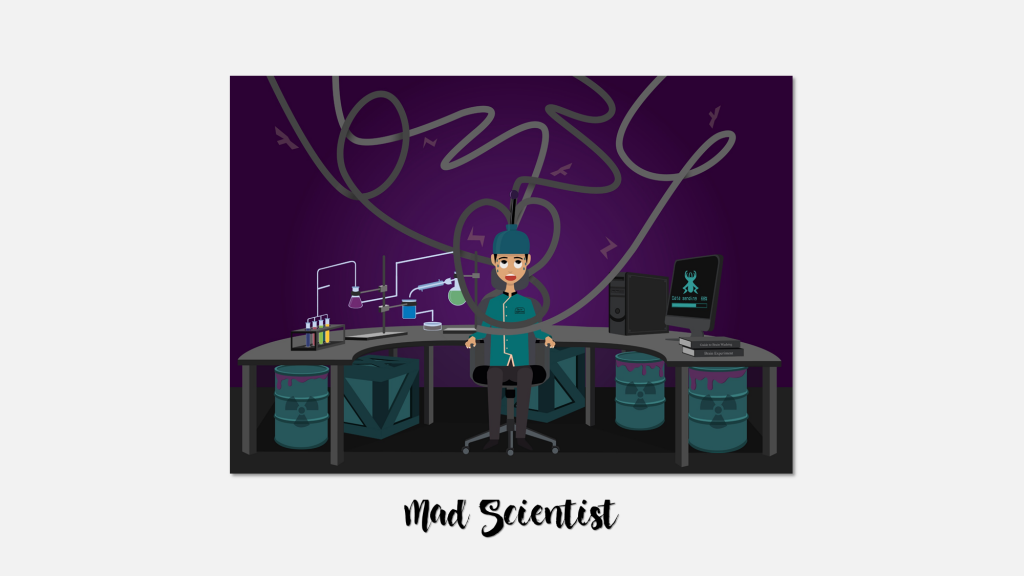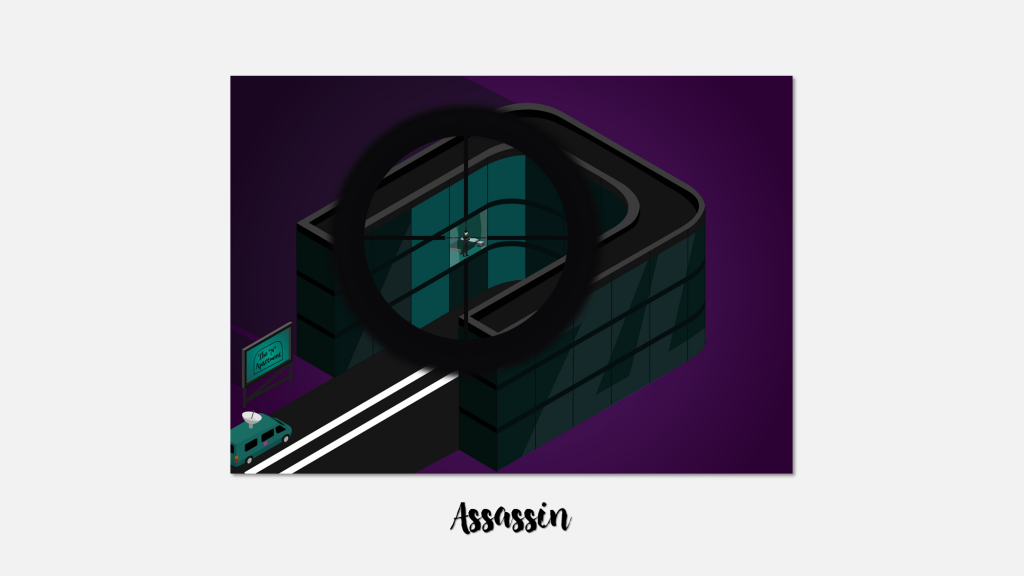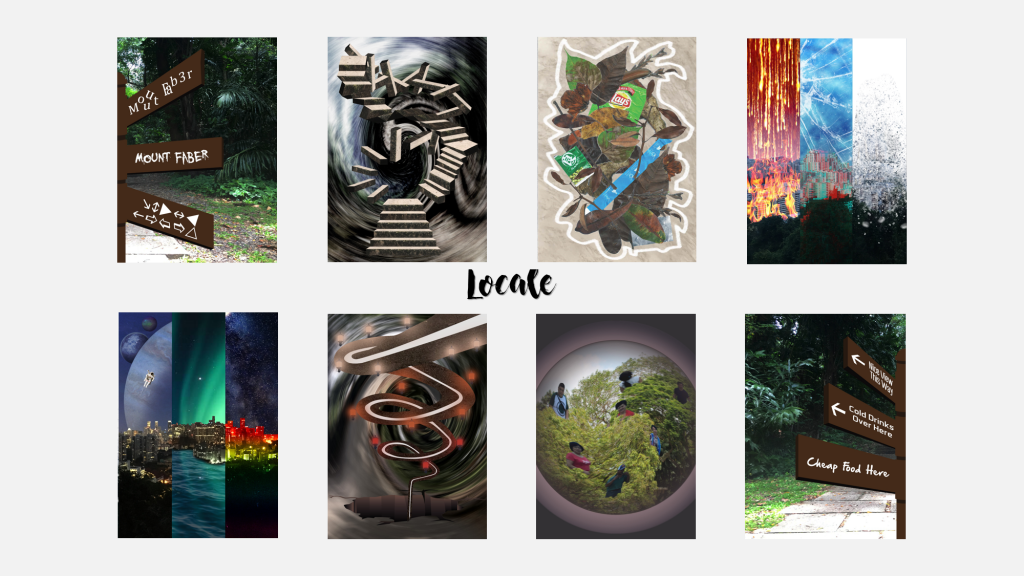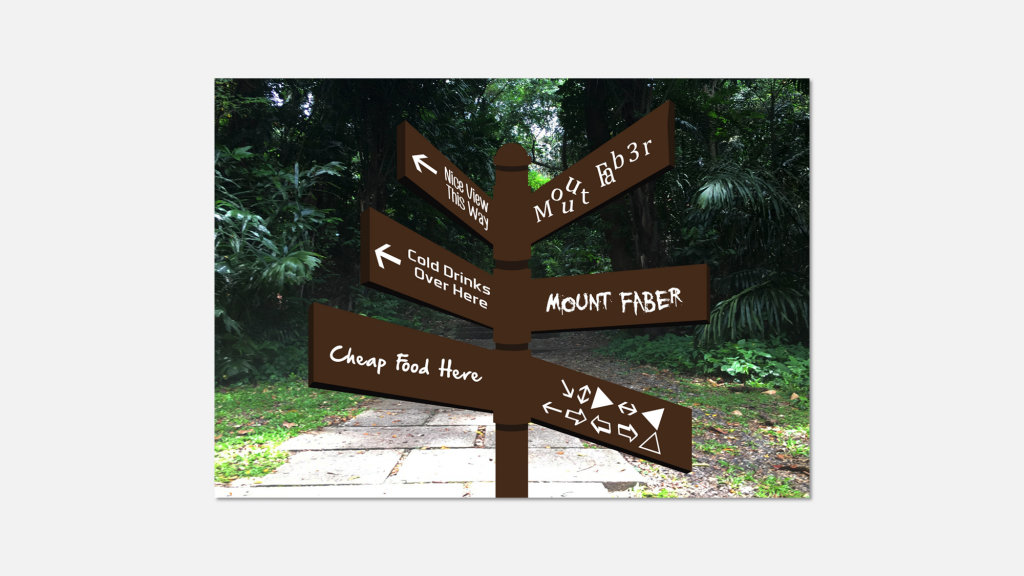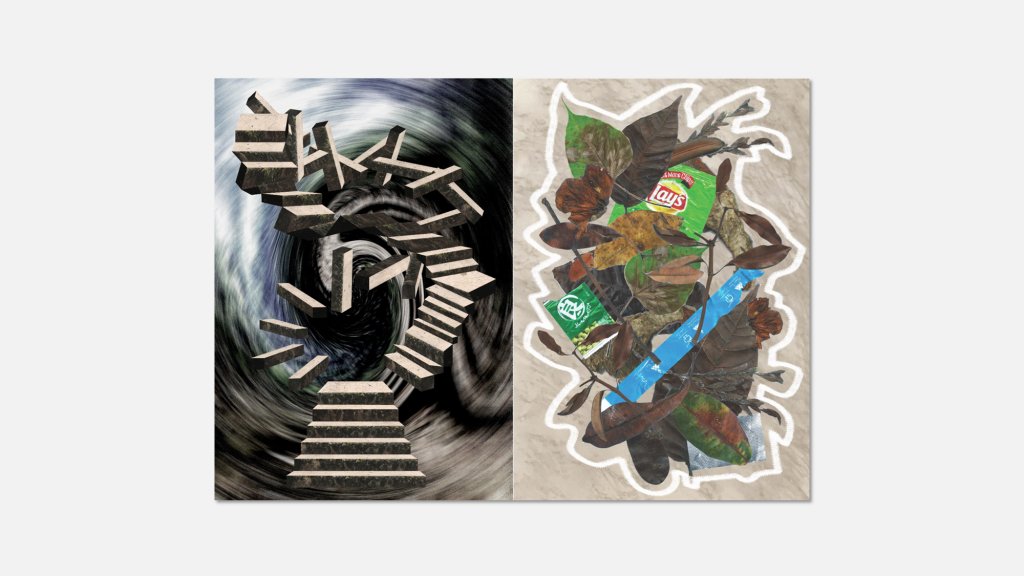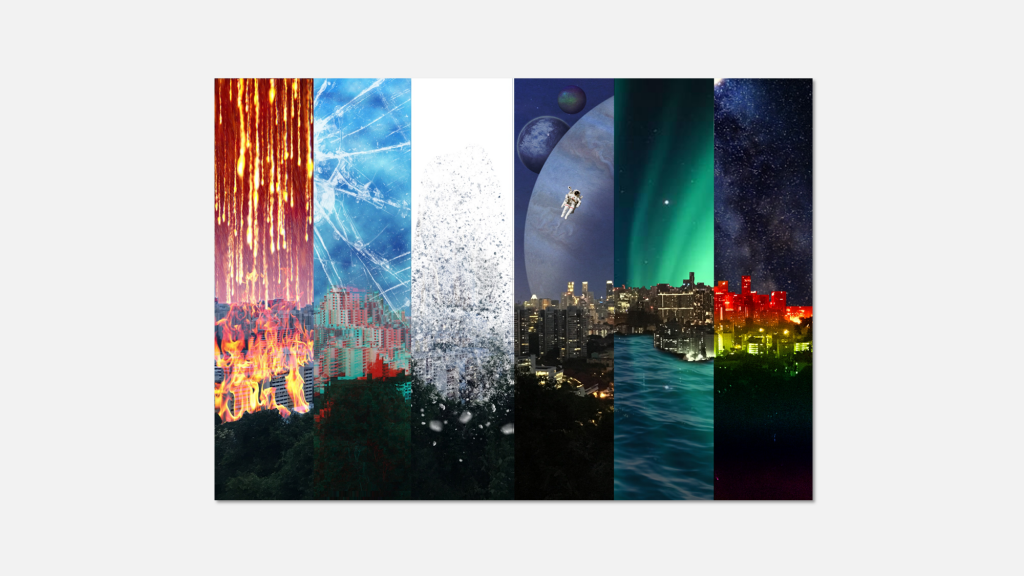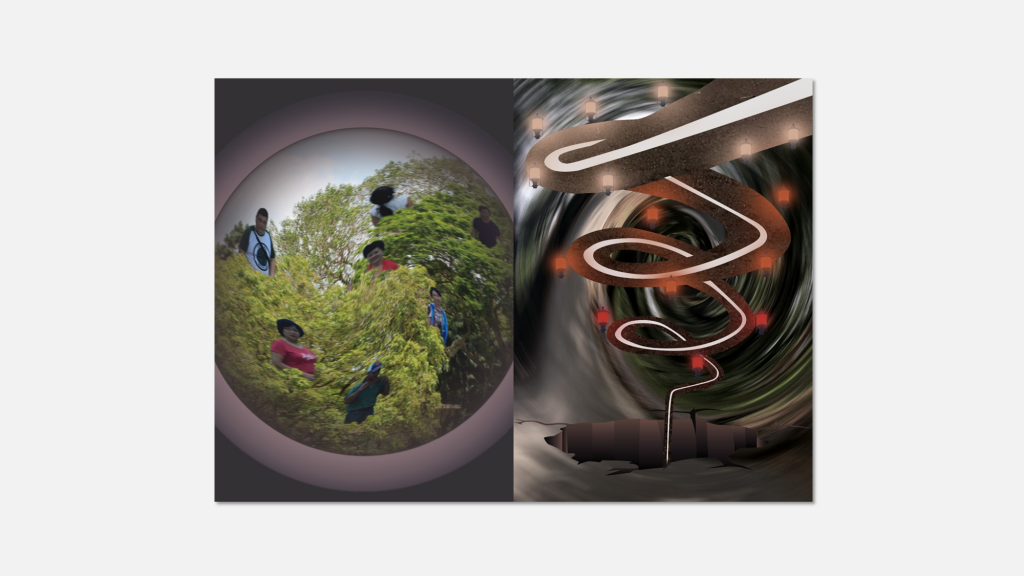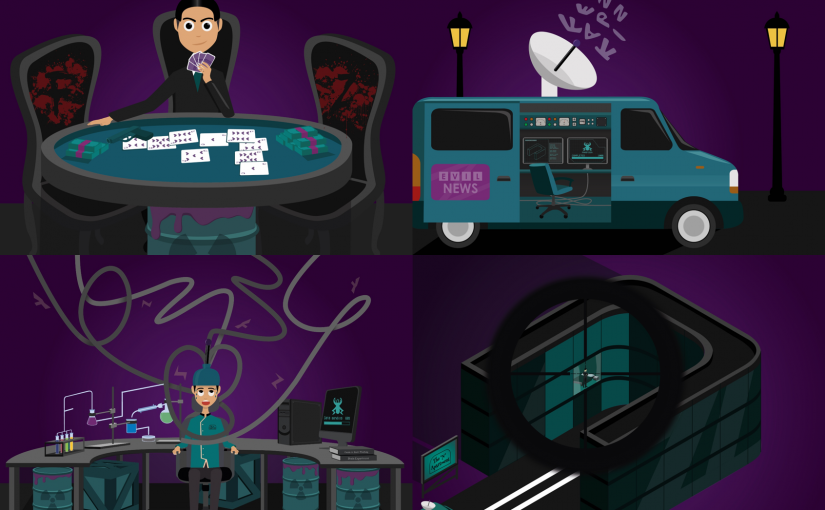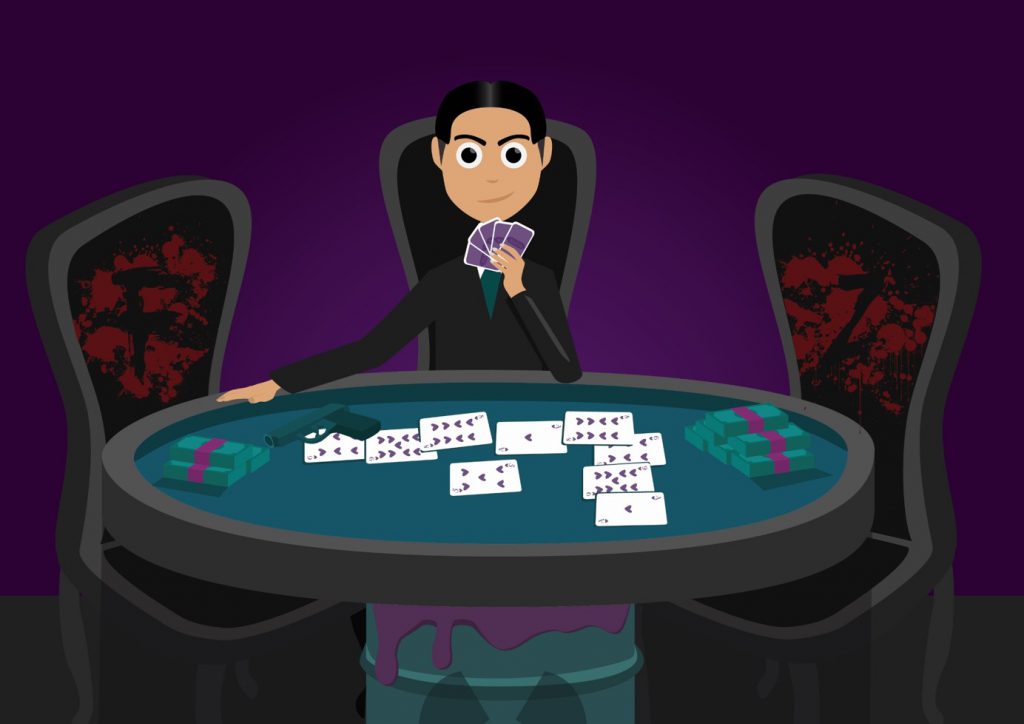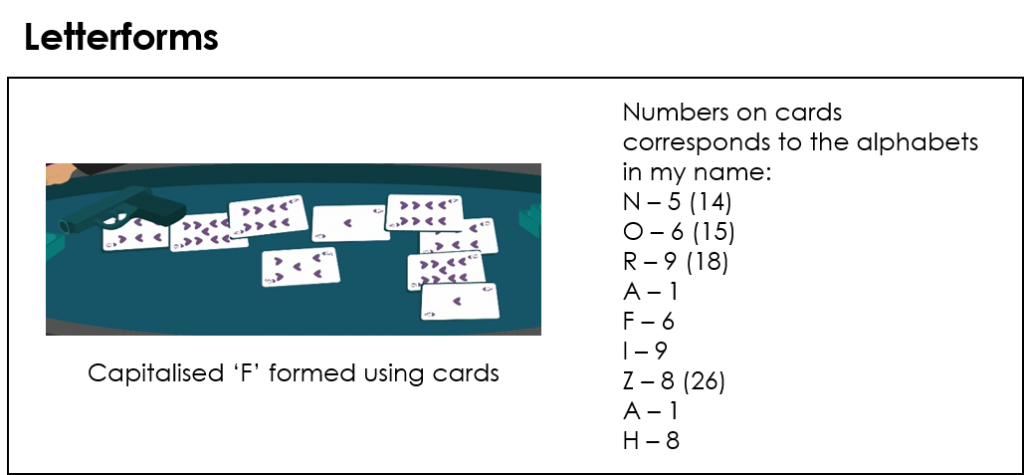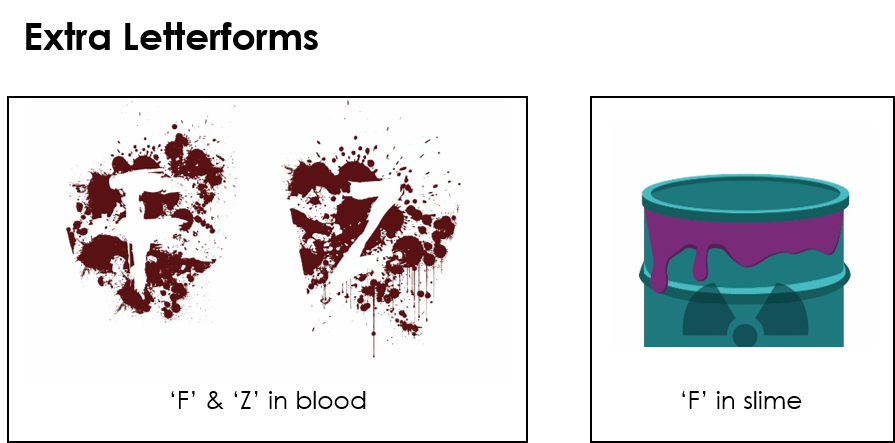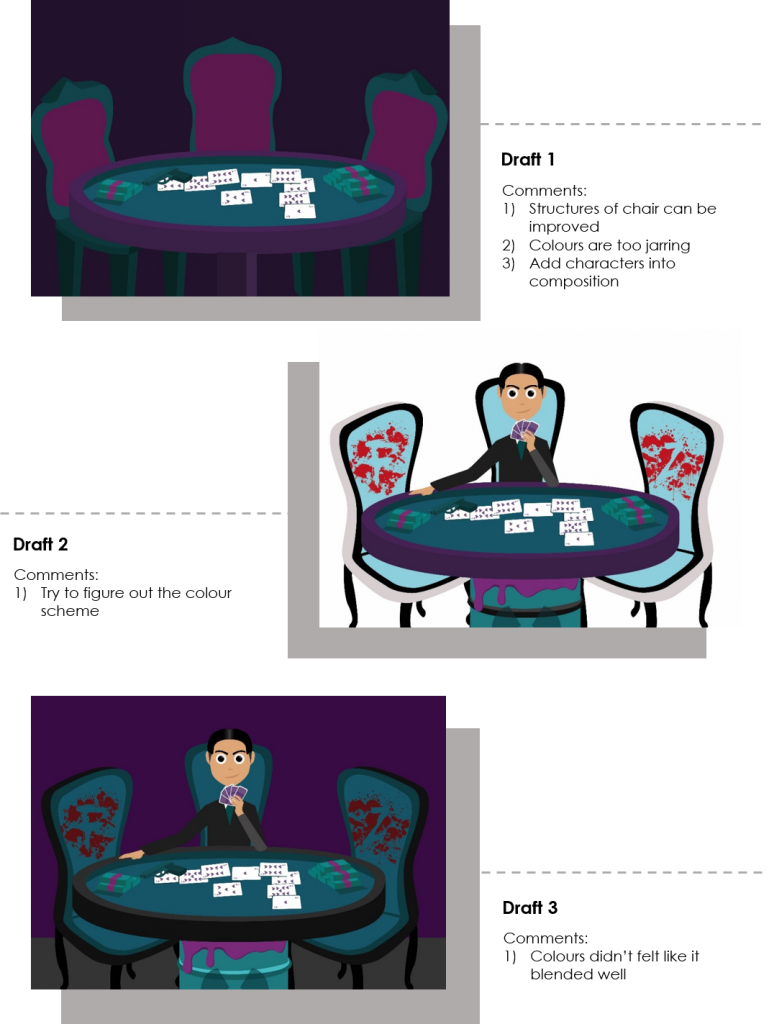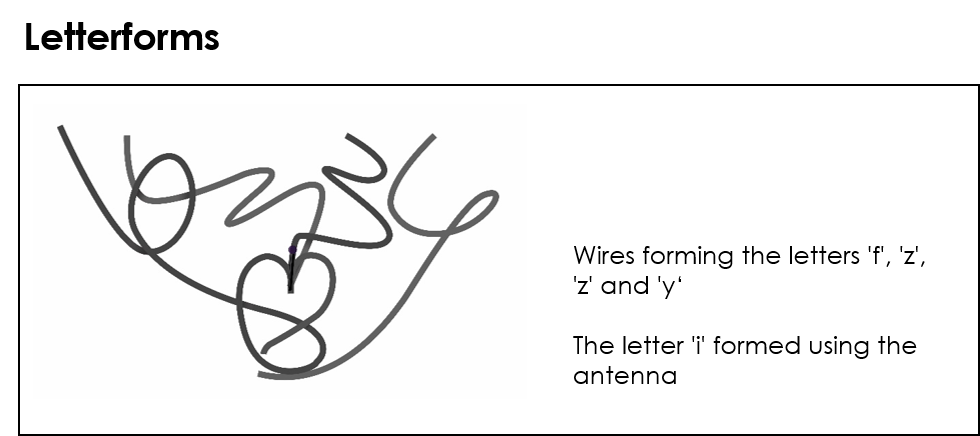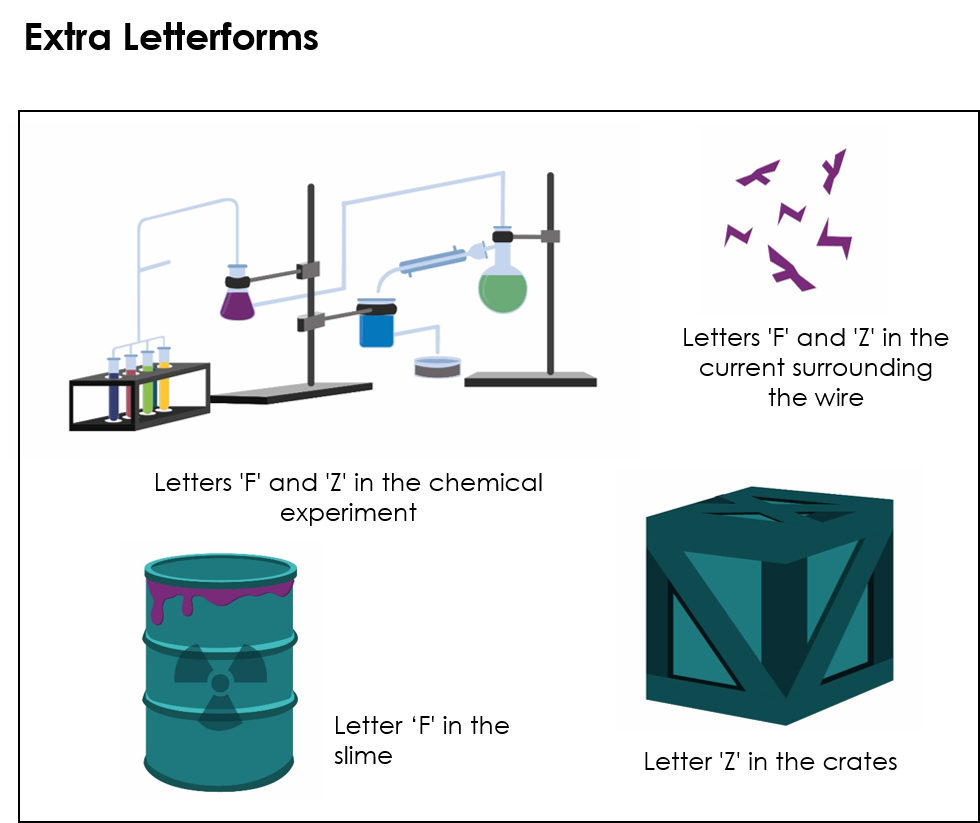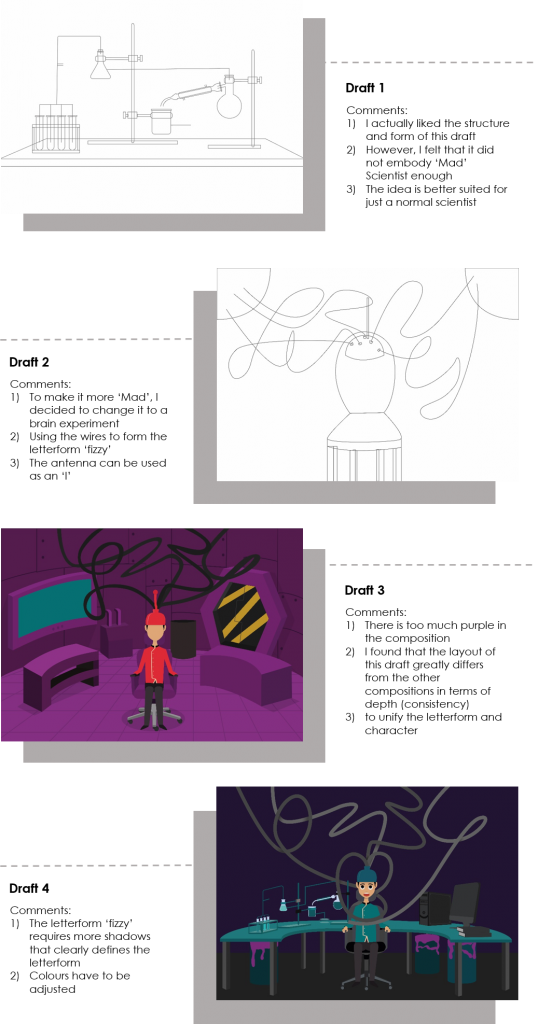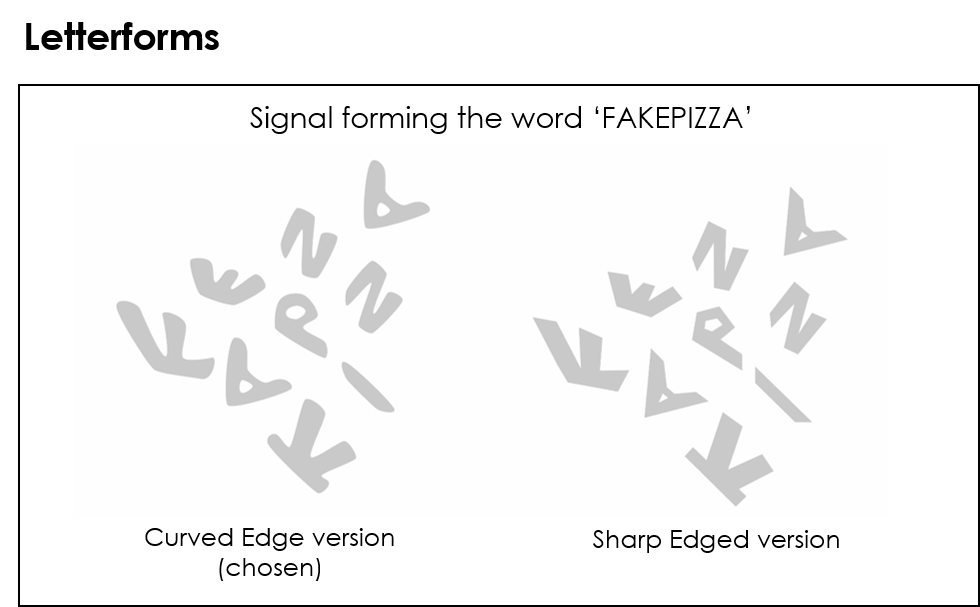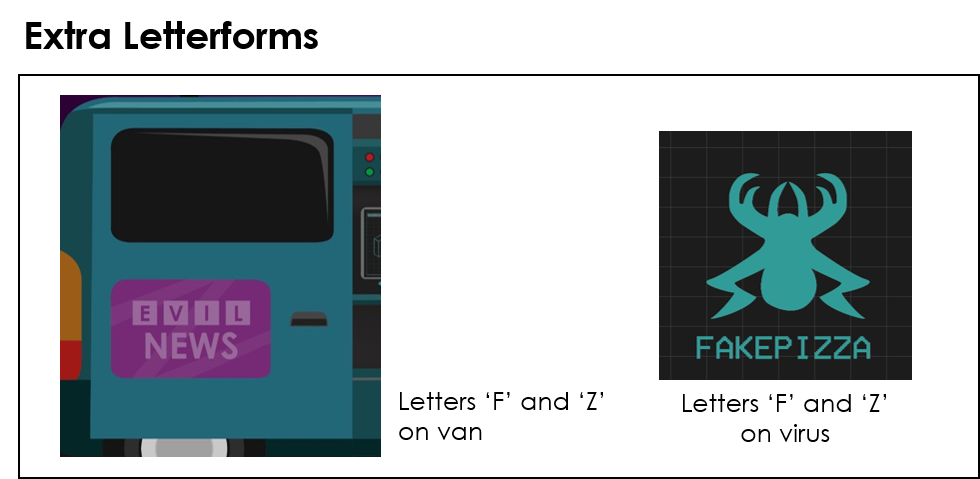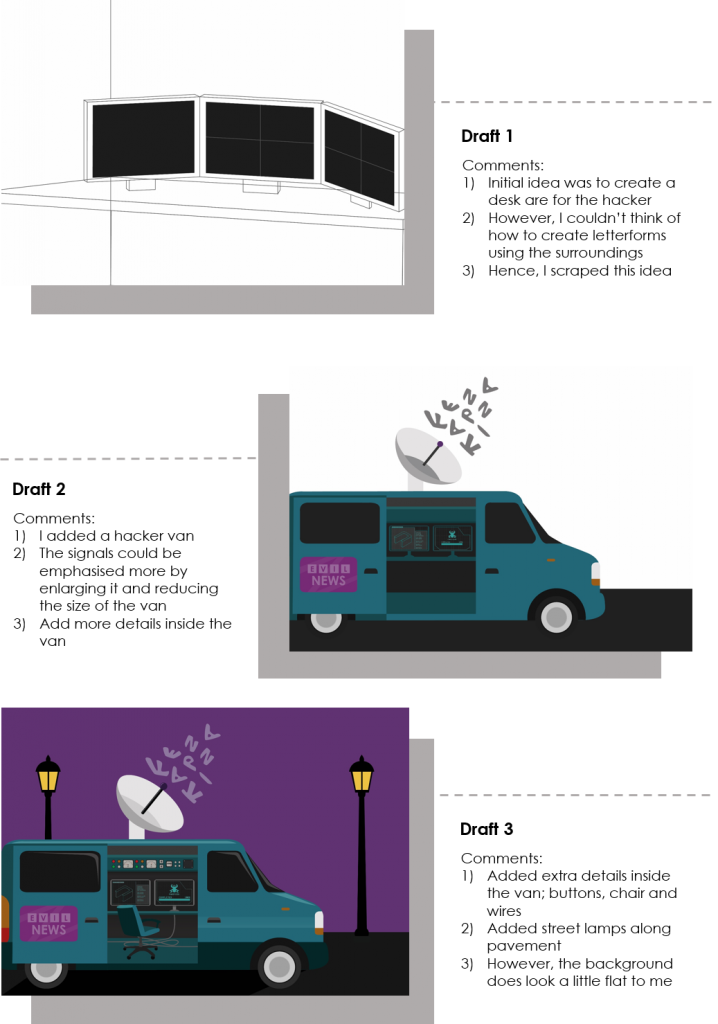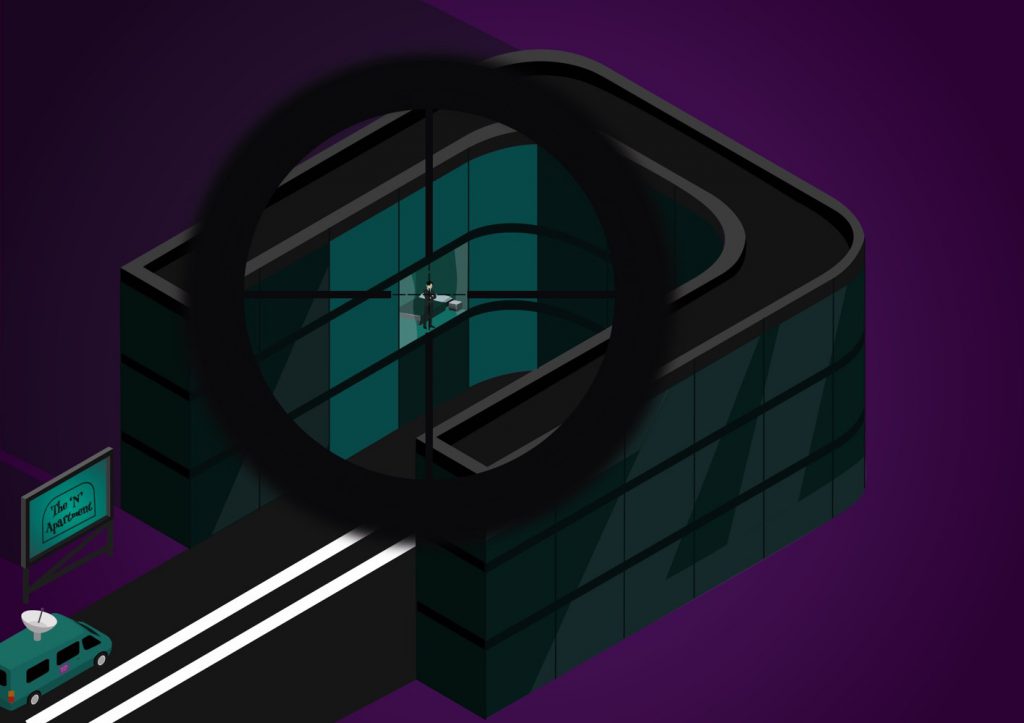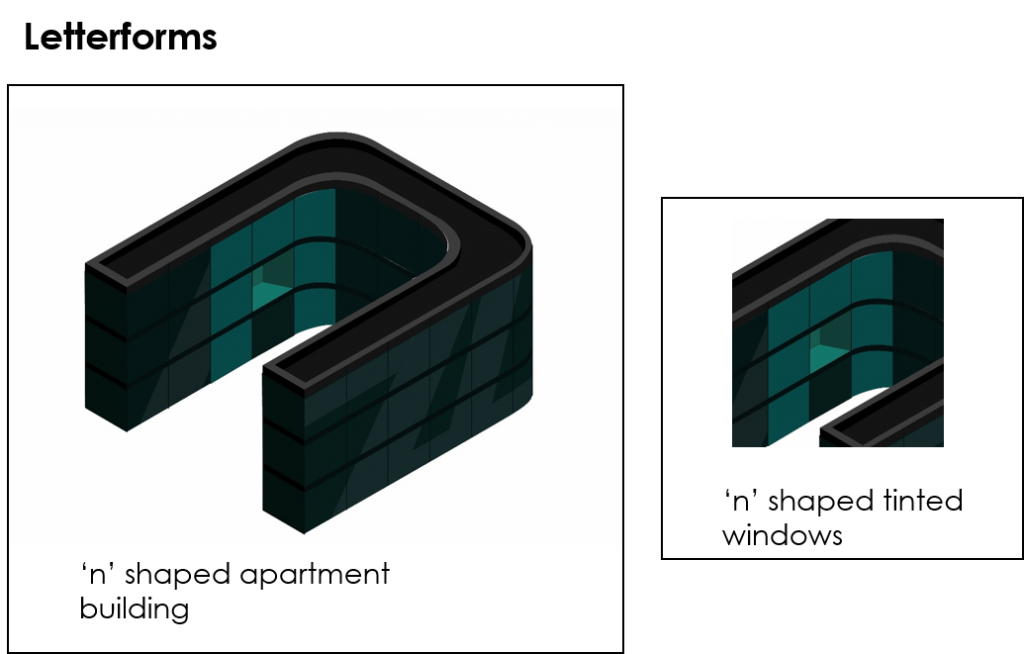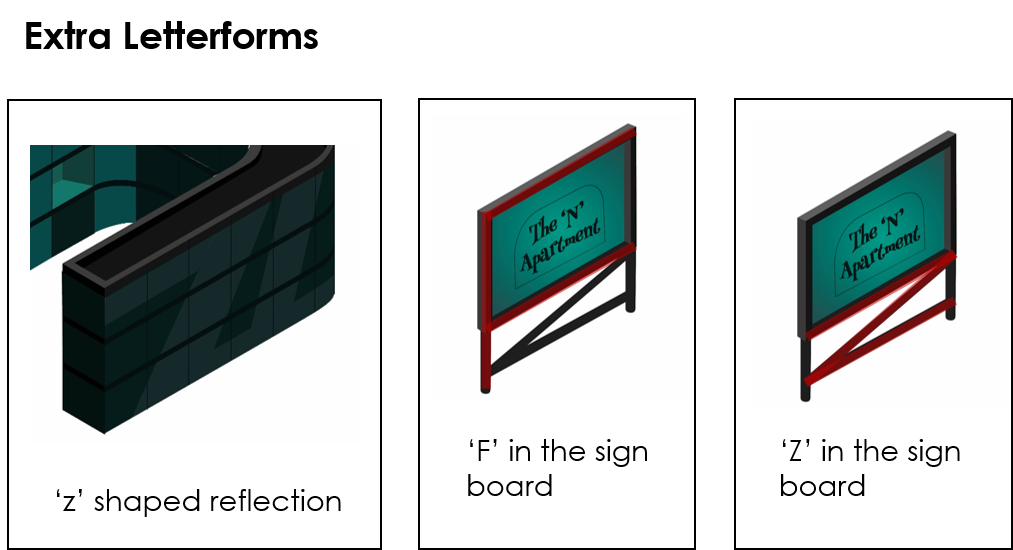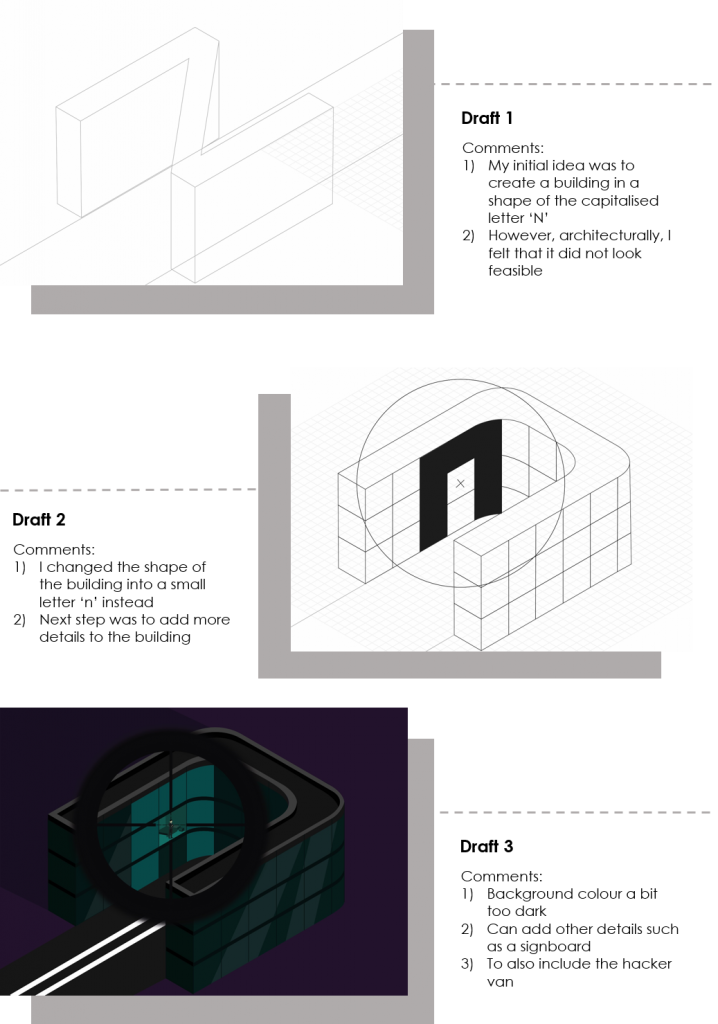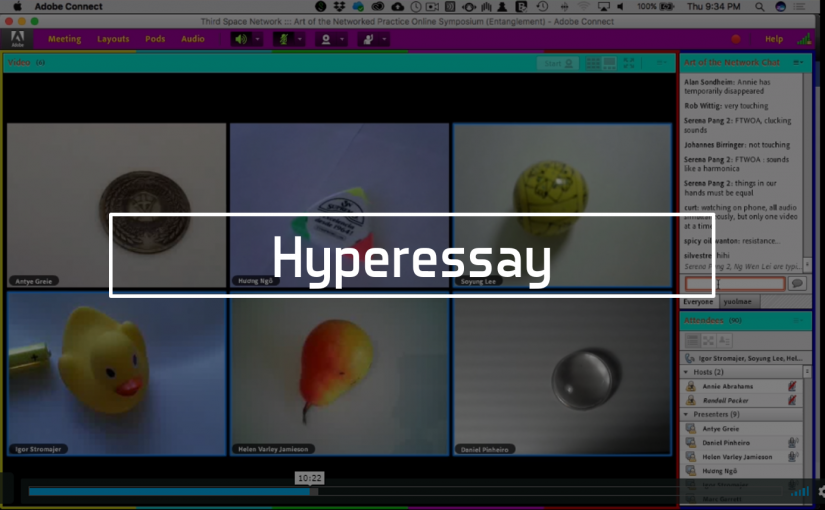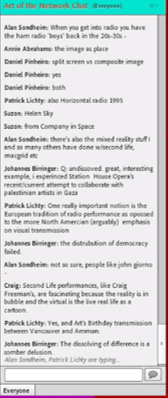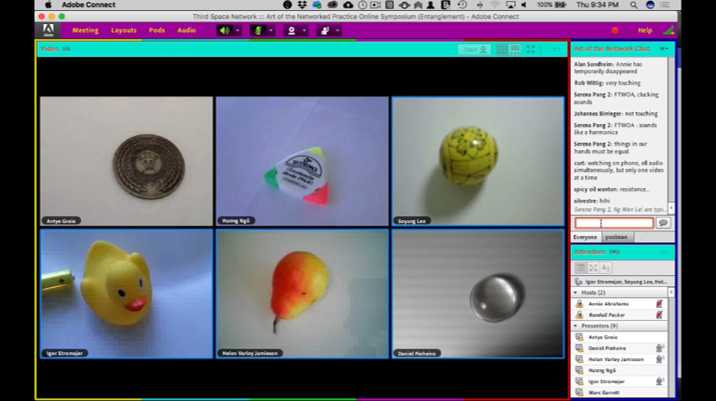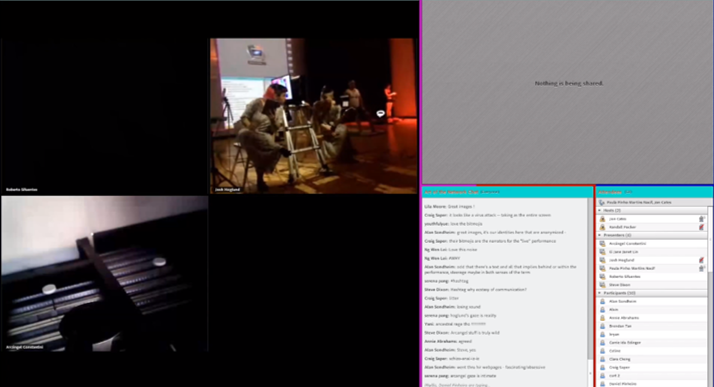Month: April 2018
Locale | Mount Faber Zine
Click here for links to other posts: Research | Zine Process
Mount Faber
After much deliberation, I decided to stick with “selling” Mount Faber for its views. However, for the zine, I figure to add a personal touch. Hence, each page illustrates what I saw and felt as I enter and leave Mount Faber. The zine follows the narrative of my personal journey through Mount Faber.
Throughout the zine, I wanted to create a connection between the pages in a spread that showcases some parallels.
Spread 1
A full spread that combines together to form one image.
OFC (right): Displays the start of the journey through Mount Faber
OBC(left): Displays the end of the journey through Mount Faber
Spread 2
Page 2 (left): Displays the journey up Mount Faber
Page 7(right): Displays the journey down Mount Faber
Spread 3
The main theme for this spread is juxtaposition.
Page 3(right): Shows the juxtaposition of natural and man-made.
Page 6(left): Shows the juxtaposition of peace and noise.
Spread 4
One continuous spread that shows a timelapse of the view manipulated to reflect different emotions felt.
Outside Front Cover Page
To illustrate the idea of being in a state of confusion because I wanted to show how in the beginning, I had no idea what to expect from Mount Faber.
The first thing you see when you first arrive is the signage seen below:

I tried to replicate the shape of the sign to the best of my ability. The sign features 3 different fonts used that reflects the confused emotion.
Page 2
If you enter Mount Faber via the Marang Trail, you will first be greeted by a flight of stairs. In the beginning, climbing was easy. However, as it got higher and higher, the exhaustion starts kicking in. Unfortunately, that was when I started feeling giddy and nauseous (a sign that I would blackout soon).
To illustrate this experience, I decided to keep the stairs as a motif for this page. At the base of the stairs, we see a usual flight of stairs. However, the stairs start to warp into a weird configuration that looks impossible to climb.
The stairs on the left were created to look like steps that are rotated into weird position. Whereas the stairs on the right show how the steps are extremely uneven and going in weird directions. Both stairs illustrate the gradual increase in distortion.
I wanted to use as much of the site as possible, hence I used the texture from the stairs in Mount Faber to form the stairs. Textures were taken from this photo:
Page 3
Naturally Manmade – that was the theme for this page.
When you reach Faber Peak, you will see the building that holds the cable car station and restaurants. Interestingly, the building is surrounded by lush greenery and is a stark contrast from the climb up. Thus, I wanted to highlight the juxtaposition of the man-made building with nature.

I collected leaves, twigs, flowers, and tree barks to represent the nature aspect. Whereas for the man-made aspect, I collected litter that was left behind my humans such as food wrappers and cable car ticket. (I was contemplating whether to take the cigarette buds on the floor buuuuuuut, that is a little unhygienic)

I scanned all the items onto the computer in high resolution to capture as much details as possible. After which, I created a photo collage of all the images to form a pile of leaves with the wrappers and ticket hidden in between.
The background of this page was created using etching of a man-made rock. I thought that this blended well with the theme of the page because it demonstrated the idea of nature + man-made.
Page 4 & 5
Original image:
The center of my journey in Mount Faber was watching the sunset and the lights in the estates turn on at Faber Point.
In order to show the change in time, I decided to create a timelapse of the scenery. I stood at one spot from 7 pm – 8 pm, capturing the moment the sun goes down. I recorded the emotions I felt at the time the image was captured.
I incorporate the emotions felt into each panel by using photo manipulation and exaggerating the emotions.
Page 6
The theme for this page is the juxtaposition of peace with noise.
As I was going down Mount Faber, I was met with many noisy tourists, even though we are in such a peaceful environment.
Thus, I created a photo collage of noisy tourists peeping out of the trees (representing nature). I used photos of tourist that I captured while taking photos of the scenery.
I added the twirl distortion to add a dystopia effect. The image of the tourist and trees are framed through binoculars. I used the photo I took below as reference to create the frame:

Page 7
In this page, I wanted to highlight the journey leaving Mount Faber. Because I had to take a time-lapse shot of the sunset, by the time we left, it was completely dark and deserted.
At Faber Peak, the lights were still quite bright. However, when we reach the beginning of the Marang Trail, we realized that there were no lights at all, it was in complete darkness.
Instead, we decided to walk along the road. As we went down, it got scarier and scarier. At one point, we almost got lost, the signs lead us to a deserted road that was completely quiet. We were honestly worried about whether we were going to get out of this place.
The road on this page was reflected in a spiral fashion to illustrate the discombobulating emotions felt while going down. It was also designed to be thicker at the top and gradually gets thinner and thinner as it goes down. This is to demonstrate the constricting feeling where we got worried for our safety.
To show how we have no idea whether we will able to find our way, the road ends with a sharp dive and leads to a pit hole. I also added the lamps to represent the gradual decrease in the number of lights. At the top, there are more lights in normal white colour. However, as we go down to the middle, the colour changes to orange and the number of lights also decrease. Then finally, at the bottom, there were barely any lights, and the red light was used to illustrate a sort of sinister feeling.
I made use of a photo I took of the street lamp to create the light.
Outside Back Cover Page
Finally, to end it off, I used the same signage as the outside front cover page. However, this signage depicts clearer directional signs. This is to show how after leaving Mount Faber, I am now familiar with what Mount Faber has to offer. For example, where to get cold drinks, cheap food (vending machine, unfortunately), and where to find the best view.
Reflection
Just like how the last page shows the end of my journey through Mount Faber, this marks the end of my journey through Graphic Forms.
This project was quite out of my comfort zone because I usually prefer working with vectors rather than images. This was one of those rare moments where I made use of photo collage and photo manipulation.
A comment from Joy was specifically to Page 3, where she mentioned how I should have added my own personal touch to it. That didn’t occur to me until Joy brought it up.
Throughout consultations, I found that Joy fervently mentions every consultation on how I should exaggerate it even more. That really pushed me out of my comfort zone because I usually like to keep things subtle.
Overall, there are certain things that I wished I could have done better such as the cover page and Page 6. But I did enjoy the entire process of making my zine.
Graphic Form will be greatly missed.
Locale | Zine Process
Click here for links to other posts: Research | Zine
Disclaimer: The following showcases the process towards my final artwork, that shows my thought process, all the ideas I thought of which includes rejected ideas, research. So it can get pretty messy. Think of it as my visual journal 🙂
To view my final artwork please click here.
Idea
To create a story of my journey to Mount Faber?
Highlighting the progression of the sight I see as I make my way up?
Showing the changes in scenery as I move up
Background of abstract forms, juxtaposed with an image in the center and a short caption?
Abstract form – showcasing emotions from the 5 senses?
Using an element from the location and interpreting its form with the emotion I feel
Mini booklet inside with a photo book? OR just a picture of the actual scene?
The 2 sides of the book is a continuation but with a different emotion, for example:
Pg 1 and 8
Pg 1 – A confused signage (Directions pointing nowhere)
Pg 8 – A clearer signage (directions pointing to emotions)
Pg 2 and 7
Pg 2 – A climb stairs motif (difficult steps, sharp edges) – black background, white steps
Pg 7 – Downward slope (smooth hill) – white background, black steps
Pg 3 and 6
Pg 3 – Nature juxtapose with infrastructure – a patterned background
Pg 6 – peace and serenity juxtapose with noisy Chinese tourists
Pg 4 and 5
A full length view of the scene from Faber Point recreated in a colour that celebrates the emotions I felt – bottom half shows the scenery, top half shows patterns?
Since I’m dealing with the idea of views, I was thinking about focusing primarily on the sense: sight by creating a progression of the sights I see through my journey at Mount Faber and correlate it to the emotions I felt.
Journey through Mount Faber
- Arrival at Mount Faber – anticipation of what is to come (cover page) – a complicated signage that doesn’t make sense (half of the signpost)
- The climb up to Mount Faber – worrisome, tiring juxtapose with peaceful, calm, serene (second page) – stairs motif
- Faber Peak – The modernity of the building juxtaposed with nature surrounding it (3rd page)
- Faber Point – the amazing view of the HDB estates and the harbour – recreating the scenery in a colour that celebrates the emotions (centre page 4th & 5th page)
- Faber Point – the crowd – mainly Chinese tourists, crowded, sort of ruins the peaceful atmosphere (6th page)
- Climb down Mount Faber – downward slope, calm, peaceful – another stairs motif (7th page)
- Leaving Mount Faber – a clearer image of what Mount Faber has to offer – other half of the signpost (8th page)
Transformation
To view final artworks, click here.
Locale | Mount Faber Research
Click here for links to other posts: Zine Process | Zine
Research Presentation
Unique selling point
Before this, I had never visited Mount Faber before. So I didn’t know what to expect. However, what captured me the first time I was there were the amazing views of Singapore. One of the best views I have seen in Singapore was from 1-Altitude, which had a panoramic 360-degree view of Singapore. But, the view from Mount Faber brought me back home. As compared to the view from 1-Altitude, I felt that the view from Mount Faber was in a sense more relatable because it showed the everyday humble side of Singapore, rather than the high-end luxurious side. It offered the views of HDBs, condominiums that we as Singaporeans usually see.
Hence, for this project, I decided to focus on Mount Faber’s views as its USP and how Mount Faber’s facilities and infrastructures were structured in a way that centralizes and highlights its view.
Background
How did Mount Faber come about?
Originally named Telok Belangah Hill, in July 1845, the hill was renamed Mount Faber in honour of Captain Charles Edward Faber of the Madras Engineers, who built a narrow winding road to the summit for the installation of a signal station.
Sources from: http://eresources.nlb.gov.sg/infopedia/articles/SIP_29_2005-01-25.html
What is Mount Faber?
- Located in the town of Bukit Merah in the Central Region of Singapore. It overlooks the Telok Blangah area and the western parts of the Central Area
- One of the oldest parks in Singapore
- Covered by secondary forest – “consists of vegetation which have developed after the destruction of the original ‘primary’ vegetation”, definition from Lee Kong Chian Natural History Museum.
- Park size: 56 hectares
- Elevation: 106m above sea level
- Third highest hill (the highest hill being Bukit Timah Hill, second Bukit Gombak)
- Opens 24 hours, park lighting times: 7:00 pm to 7:00 am daily
Sources from: https://www.nparks.gov.sg/gardens-parks-and-nature/parks-and-nature-reserves/mount-faber-park
How to get there?
By car:
The summit is accessible by Mount Faber Road or Mount Faber Loop via Morse Road
By walking/hiking:
The main paths are,
Marang Trail which leads from Marang Road at the Harbourfront MRT station (Exit D)
Southern Ridges Park Connector which connects you from Telok Blangah Hill Park, Kent Ridge Park, and Henderson Waves.
By cable car:


Board the cable car that will bring you to Mount Faber from either Harbourfront Station or Sentosa Station.
Additional Primary Research: The staffs at the Cable Car Counter mentioned that the best time to take the cable car is from 2 pm – 4 pm.
As a poor Uni student, I have not had the chance to take to the cable car to Mount Faber. I have taken the Marang Trail up Mount Faber and personally, for someone who doesn’t mind hiking, I enjoyed the scenery and experience. However, since young, I occasionally experience mild blackouts whenever it gets too hot and when I overexert myself. Unfortunately, I experienced it while hiking up. Even though I enjoyed the hiking experience, for a more comfortable experience, I do prefer the option of taking a car up.
If you take a Grab up from VivoCity, it would only cost you around $7 – $9.
Facilities
Pavilions

In total, there are 17 pavilions in Mount Faber. From my observations, these pavilions are strategically situated in locations that face the view. Here are some photos of the pavilions:
Restaurants
There are 2 restaurants at Mount Faber:
(1) Spuds & Aprons
Indoor Dining Area

Outdoor Dining Area

Private Dining Area

Sources from: Faber Peak Venue Information
(2) Dusk Restaurant & Bar
The restaurant has been featured on Night Owl Cinematics on their weekly food hunt, called Food King. Interestingly, it was shown in the episode that featured romantic dining places with a view.
First Survey Results
After conducting the first survey, the comments given were that the questions may be too broad and that I should highlight a unique selling point. However, as we discussed, I figured that I can use my results from the first survey to figure out what was the pull of Mount Faber. After analysing the results, I concluded that the unique selling point should be the views that Mount Faber has to offer.
Thus, I embarked on my second survey that focuses on the views.
Second Survey Results
My experience
Sight: A lot of trees, nature, walking paths, observation decks, bells, infrastructures, pavilions, CAT
Smell: Fresh air, nature
Sound: Birds chirping, Cicadas, Leaves rustling, Noisy tourists
Taste: After the hike and being under the hot sun, we were really craving for some cold drinks.
Touch: There were so many nice views, that I found myself constantly using my phone to take photos. Here are some nice views I caught.
Image Making Through Type | Evil Villains
To view my process, click here.
Theme: |
Evil Villains |
Concept: |
A scene from the job (dark colours) |
Story: |
#teamvillian #teamvoldemort #deatheaters
Being an avid fan of villains in movies and books, I decided to use it as the theme. Some of my favourite villains are Voldemort (Harry Potter), Bellatrix Lestrange (Harry Potter), Cruella de Ville (101 Dalmations), Scar (Lion King), Davy Jones (Pirates of the Caribbean).
I began my research into the jobs that are associated with villains and from that research I decided on my 4 evil villain jobs.
The Hacker: The unnoticed villain. Often known as an evil sidekick. As the name suggests, their primary job is hacking into computer servers to collect information or to unleash computer viruses into systems.
The Assassin: The Main Villain don’t like to get their hands dirty, so they rely on the Assassin when it comes to assassinating their targets. Primary weapons used for assassination includes gun and knife.
The Mafia: Often working in a group, the Mafias are a crime syndicate managing and controlling the crimes in a certain area. They are usually involved in gambling, drugs, loan sharking, and the black market.
The Mad Scientist: The creator of evil gadgets, chemicals and weapons. The Brainiac of the evil community. Without them, the Main Villain will be nothing. Setting themselves apart from a normal scientist is that the purpose of their creations is used for evil instead of the greater good.
Unfortunately, these jobs are not possible future career options (for obvious reasons), I’ll stash them away in my list of impossible things to do. Nonetheless, it is fun to imagine what it is like to be working in this jobs.
|
Art Style: |
With a villain theme, it only fits to use dark colours in my compositions to display a sinister image. Thus, for the colour scheme, I made use of different shades of purple, teal and black.
The compositions were crafted from a first-person perspective thus allowing the viewers to look into the composition from the perspective of the villain characters. The letterforms used are meant to blend in with the surroundings as much as possible. To achieve this, I used objects associated with the occupation and made use of the characteristics of this objects to form a letterform. This will be further explained below.
I also intended to include a repetitive motif of the letters F and Z that is consistent throughout the four compositions. These letters are what I feel defines my name.
I connected the four compositions together by creating a narrative.
The Mafia has been gambling with an enemy. In this gambling game, if you lose, you get shot. Unfortunately, the Mafia lost but was spared with the condition that she becomes a slave to the enemy. The Mafia, unhappy, enlisted the help of his fellow Assassin to kill the enemy.
However, to achieve this mission, there are other tasks that needs to be completed.
In order to kill the enemy at the right moment, the Hacker has to hack into the system to shut down the building. To shut down the building, the Hacker requires data about the building, thus enlisting the help of the Mad Scientist who has captured an employee of the apartment building to extract data. In return for the favour, the mafia, dwelling in the black market, attained toxic waste for the Mad Scientist. |
Final Artworks
1.0 Mafia
1.1 Process of mafia
2.0 Mad Scientist
2.1 Process of MAD SCIENTIST
3.0 Hacker
3.1 Process of Hacker
4.0 Assassin
4.1 Process of Assassin
Reflection
Personally, I felt that I was being overly ambitious for this project in terms of creating details. In my usual artworks, my details were minimal, hence I decided to challenge myself for this project. However, I felt that because I was so focused on creating details that I forgot the primary essence of this project which was the letterforms. I believe that I could have done better if I wasn’t so hung up on creating details.
A comment from Joy was about my letterforms where there was no significance to my letterforms. For example, for my mafia piece, the letter ‘F’ on the table doesn’t need to be an F, it could be any letter. Hence, I should have looked into the significance of the letters and why I chose to represent it in a specific way.
Lastly, because I was going for the dark concept, when it came to printing, it definitely came out a lot darker than I wanted it to be. So note to self: If you want to create dark artworks, make sure to brighten your artworks first. Also, printing on matte paper could make it appear brighter as compared to glossy paper. (Just a theory than I noticed)
To view my process and research, click here.
Image Making Through Type | Process and Research
Disclaimer: The following showcases the process towards my final artwork, that shows my thought process, all the ideas I thought of which includes rejected ideas, research. So it can get pretty messy. Think of it as my visual journal 🙂
To view my final artwork please click here.
OLD
Theme: Dark Jobs
First person perspective
| Job | Alter ego | Scene | |
| 1 | Private Investigator | NN | Crime Scene
– Dead body – Murder weapon – Broken window |
| 2 | Sniper | 飞走 | Busy Shopping streets
– The target wearing a shirt with the name on it
|
| 3 | Hacker | fakepizza | Computer table
– Codes – Many screens – Board in the background with a target |
| 4 | Mad Scientist | Professor Fizzy | Science lab
– Beakers – Chemicals – Smoke |
Research
Russian Constructivism
Constructivism has its origins from Russia in the year 1913 and was a development from the Russian Futurism after World War I. It was a movement created by the Russian avant-garde.
It involved creating completely abstract work with a blend of modernity. Often times, we see geometric and experimental forms which are rarely emotional. It is meant to convey a universal meaning rather than personal meanings.
Famous artists include Vladimir Tatlin, Kasimir Malevich, Alexandra Exter, Robert Adams, and El Lissitzky.
Vladimir Tatlin was central to the birth of Russian Constructivism.
He was largely influenced by Picasso’s Cubist and Russian Futurism. He wanted to create art with modern purposes. He was trained as an icon painter, but was eventually inclined to the possibilities of materials in his work such as metal, glass and wood. He believed that the materials an artist used should reflect their capacities that explores its uses. His most remembered work was his Monument to the Third International (1919-20) – a design for the Communist International headquarters which unfortunately was realised as a model but never built.

References:
http://www.theartstory.org/artist-tatlin-vladimir.htm
http://www.arthistoryarchive.com/arthistory/constructivism/
http://www.tate.org.uk/art/art-terms/c/constructivism
Unconventional Methods:
Tape Art


String Art



Push Pin Art

Paper Art

Graphics:


NEW IDEA
I decided that dark jobs just didn’t seem suitable enough. So I changed it to Evil Villains instead. Unfortunately, I have to remove Crime Scene Investigator from the list.
Other Villan Jobs:
- Witch
- World Dominator
- President of USA
- Serial Killer
- Clown
- Lawyer
| Evil Villain Job | Alter Ego | Location | Items | |
| 1 | Mafia | Mdm F | Hideout | Gambling table, Stacks of drugs, money, jewelleries |
| 2 | Mad Scientist | Professor Fizzy | Science Lab | Beaker, chemicals, thermometer, smoke, pipes |
| 3 | Hacker | fakepizza | Dark Basement | Monitors, Hacking screens, fakepizza virus, world map on screen |
| 4 | Assassin | nn | On top of a high rise building | Apartment, windows, road, cars, |
Sketches
Comments from Consultation:
- Link all 4 jobs together
- Form an evil organization
- For Mad Scientist, the current set up didn’t appear “mad” enough – more suitable for a normal Scientist
To see more of how the artwork changed, have a look at my final post here.
Micro-Project 6: A Day in the Life of Super-Participation
(In collaboration with Clara, Minjee, Tanya, and Youlmae)
24 hours on social media… In the beginning, that sounded really fun. Oh boy, was I wrong…

Rules of the Tangy Young Classy Fine Mingoes:
- to post an update every 30 minutes for 24 hours on the Facebook Page
- to appear to be having a conversation with each other on the page
- use as many ways possible to show the updates
I felt that before this project I was already sorta addicted to checking social media (more of a nothing-better-to-do/boredom thing). But after this project, I had a realization that actually my addiction isn’t as bad as I thought it was.
Having my phone around with me 24/7, social media is available to me with just a click of a button.
However, I realized that my dependency on social media was more towards an entertainment platform rather than communication. For example, I would rather be scrolling through social media reading memes, than posting tweets about what I did.
At first, the idea of updating people about what I was doing every 30 minutes, did not feel like a challenge. But as I was constantly updating, I realised how this act was disrupting my day-to-day activities.
In the beginning, I felt that my group members and I were excited to start this project.
But eventually, everyone got sick and tired of having to stop whatever they were doing to post something.
On that day, I was at the Asian Civilisation Museum for my Art History research, I couldn’t even appreciate the artworks properly because I was busy looking at the clock to check whether it was time to post. Imagine trying to appreciate art, but there is something in the back of my mind, constantly thinking “has it been 30 minutes yet?”
It was a fun first experience, I’ve really never updated anybody on my whereabouts or what I was doing for 24/7.
Was it an invasion of my privacy?
Hmm… Nope, not to me. Because I still had control over what I want to post.
Will I ever do this again?
Hell no.
Glitch Singapore | Ten Courts of Hell
Links to previous post: Process | Group OSS
Trailer
General Rules
- Similar to Snake and Ladder, Virtual Players will roll the dice to determine which Court they land on
- Each Court is designated a location in Haw Par Villa
- Real Players will move to the location of the Court that the Virtual Player lands on
- The fastest team to reach the 10th Court of Hell wins
- Throughout the entire game, both players will be communicating with each other through Instagram Live, that is available for non-players to watch
- In each Court, both players will have to participate in a game
- If they win the game, the Virtual Player can immediately roll the dice
- However, if they lose, they must face the consequence by waiting for 5 minutes before they can continue
Players
|
Team A |
Team B |
|
|
Virtual Player (situated in ADM) |
Jiang Nan |
Cecilia |
|
Real Player (situated in Haw Par Villa) |
Vanessa |
Esther |
Games
Roles
DIWO/Third Space/glitch
| DIWO | Players act as co-creators by shaping the outcome of the game. We, the facilitators, only offered the framework of the game using the 10 stations. We had no control over which stations the players go to or how fast/slow they get to the end.
Players contribute to the “artwork” by rolling the dice to determine which station they go to and how they play at each station. |
| Third Space | We played with the idea of game pawns/avatars from traditional board games. Where the Virtual Players act as the force that moves the game pawns and the Real Players are the game pawns/avatar moving on the board game.
To create a third space that connects the Virtual Players and Real Players, we made use of Instagram Live. Both players will go on live broadcast together in the same “channel”. They had to play with each other through the live broadcast. Thus, the third space being Instagram Live. |
| Glitch | We allowed glitch to happen of its own accord, knowing that we would face some sort of glitch while playing the game. “Embracing the glitch”
And it did. Some glitches we faced are: – Broadcasting glitches where we lost connection with each other during the game causing some delays – Camera battery running out, causing delays to the game as batteries needed to be changed – Glitch in instructions where we understood the game differently. |
Pre-execution/preparations
Site Visit
When we first decided to create a game at Haw Par Villa, we thought that going to the actual site itself will help us in creating the stations, understanding the Ten Courts of Hell, and finding the locations for the stations.
Thus, we went to Haw Par Villa to recce the site.
During the recce, we began by visiting the Ten Courts of Hell where we observed the statues and the inscriptions for each court.
After which, we ventured around the rest of the theme park to find locations that may suit the theme of each court.
After 4 hours of looking around (well we had our own fun too), we decided on our 10 locations and started brainstorming the games we could play in each station.
Test Run
Unfortunately, we weren’t able to have a full rehearsal before the actual execution due to lack of time. Instead, we decided to do some test run of the games to ensure that the games were feasible and executable. We also enlisted the help of Brendan and Nik (he just wanted to play Twister) to test out our games. We figured getting somebody else to play our game would also give us an opportunity to see whether people can understand our instructions.

This proved to have been a good move as some games had to be tweaked because we either realized it was too easy or too difficult.
For example:
- Balance the Ping Pong Ball – Initially, the timing allocated was 1 minute, but we realized that that was a long time and we could easily complete it well below 1 minute. Thus, we changed it to 10 secs and 30 secs instead,
- Scissors, Paper, Stone – The initial idea was to have both Virtual and Real Player playing at the same time with their respective facilitator. However, their win or lose determines whether their partner gets to move up or down. E.g. if Virtual Player wins a game against the Virtual Facilitator, the Real Player has to move up the stairs. However, when testing out the game, it was taking extremely long and it got very confusing. Thus, we decided to simplify the game, with only one player playing the game of Scissors, Paper, Stone instead of both.
Guidebook
While we were testing out the games, we realized that we were having problems trying to explain the instructions and that our understanding of the game is different from person to person.
Thus, we created the Facilitator’s Guide Handbook (click here to view the document), where all the instructions for both facilitators in ADM and at Haw Par Villa are listed out. The Handbook also serves as a way for us to keep our instructions consistent with each other so that players receive the same set of instructions. Keeping the game as fair as possible.
Packing List
This was mainly a problem for the Haw Par Villa facilitators (Clara and I). Because we are at Haw Par Villa, we had to ensure that we brought everything along and nothing is left behind in ADM. It would be a complete disaster if we had forgotten to bring the game materials such as ping pong balls, five stones. Furthermore, Clara and I will be separated throughout the game, therefore, we had to have two sets of everything.
So, we set up a packing list that lists out everything we need to bring along.
| Items | IC |
| 25 paper turtles | |
| 2 small plastic bags each (1 red 1 white) | |
| 1 sets of tape each | Clara |
| 1 empty water bottle each | |
| 1 set of color paper for twister each | Clara |
| 1 spoon each | Everyone |
| 1 set of ping pong balls each | Fizah, Clara |
| 1 set of scrolls with numbers each | |
| 1 set of wet wipes each | |
| 1 set of boxes with gross things inside each | |
| 1 set of marbles each | Fizah |
| 1 plastic bag each | |
| 1 set of 5 stones each | |
| 1 tea bag each | Minjee |
| 3 paper cups each | |
| Hot water bottle each |
EXECUTION
Date: Friday, 13th April 2018
Time: 3pm
D-Day had arrived.
The nervousness in the air was palpable.
Personally, many thoughts went through my head; What if Clara and I forgot something? What if we can’t get a signal connection? What if it rains? What if security kicks us out? WHAT IF SOMEONE GETS INJURED?
I was vividly freaking out in the morning.
Before execution, we went through the Facilitator Guide Handbook together to ensure that everyone was on the same page.
Then.
It was time.
The moment we got into the car, an ominous sign appeared. It started to rain.
Amazingly, it stopped raining the moment we reached Haw Par Villa. However, the floor got slippery, so we had to be extra careful.
After about 1 and a half hour, the game ended.
Here are some highlights of the game:
- The 1st Court of Hell involves the team battle which resulted in Team B (Cecilia and Esther) winning. Thus, Team B moved to 3rd Court of Hell, while Team A moved to the 2nd Court of Hell.
- Even though Team B had an advantage, Team A was in the lead – they were at 4th Court of Hell when Team B was still at the 3rd Court of Hell.
- At the 8th Court of Hell – Body Dismemberment, the two teams finally meet each other with Team A arriving first. Unfortunately, Team A lost the game and had to wait 5 minutes, giving time for Team B to catch up. Team B manages to complete the game before Team A’s 5 minutes was over. Team A rolled a 1, hence they still had to go through the 9th Court of Hell. So, Team B rolled the dice, hoping to land a 2. But, they rolled a 1. (Mind you, both teams had been rolling a 2 throughout the entire game)
- Thus, begin the race to reach the 9th Court of Hell as both teams dashed to the location.
- Team A arrived first, hence, they get to play first. Jiangnan (Virtual Player), however, didn’t manage to find any paper stones, leading to Vanessa (Real Player) having to complete 5 rounds of paper stone. Unexpectedly, we found out that both Esther and Vanessa, the Real Players, are not familiar with 5 stones. Some time had to be taken to explain the game to them. Eventually, Team A managed to get it within one try and they proceeded to the 10th Court of Hell.
- Admitting defeat, Team B’s Esther and I took our time to reach the final location. However, the moment we reached there, Team A was nowhere in sight. The game ended interestingly with a “glitch”, not being able to determine who the winning team was.
- Unexpectedly, we realized that we managed to cover all 10 Courts of Hell.
Challenges
| 1 | Ideas | The first challenge we faced as a team was coming up with a solid plan that incorporates DIWO, Third Space and Glitch. When brainstorming, a lot of our ideas wasn’t fully able to integrate this factors well enough. For example, in one of our first few plans, Third Space was integrated last, to which we realized that the “performance” can exist without having Third Space. Thus, we had to change our idea in a way that all 3 factors must exist in order for the game to run.
Also, the first few ideas we had were overly complicated to the point that we had difficulties explaining our idea. We had to spend 4 hours on Skype discussing whether to change our idea totally or change certain aspects. |
| 2 | Finding a Location | After coming up with several ideas, we hit another roadblock. We had an issue with finding the right location. The first idea we had required us to set up an area for a period of 1 – 2 hours. This was an issue because we would require a permit or a license to set up such a space. Hence, we had to come up with an idea that would not require a permit or license. |
| 3 | Finding Players | It was a busy period for everyone in ADM so it was a challenge trying to persuade people to help us with our game. Furthermore, we required extra hands to help us with filming. There was a lot of reshuffling of players and film crew before we got our final team. |
| 4 | Preparation | A lot of time was spent preparing for the game. As mentioned previously, we had to do test runs, prepare guidebooks, and prepare the games.
Packing was another big issue. With Clara and I having to each carry a set of game items, we had to ensure that we had two sets of everything. Initially, we planned to begin the game at 3pm. However, at 3pm we were still packing our stuff in ADM. Causing a huge delay, and resulting in the games only starting at about 3.45pm |
Reflection
Overall, the game went better than what we expected. Honestly, I was mentally preparing for the worse. With the actual day being Friday the 13th, I was expecting something to go horribly.
As they say, “Prepare for the worst but hope for the best”.
I personally think that we planned the game with Murphy’s Law in our head. I felt that that really helped us to ensure that we were detailed and thorough when planning our games.
Nonetheless, there is always room for improvement. After reviewing the Instagram Live, we see a few comments from people asking “what is going on?”. It was then that I realized that from the point of view of someone who just logged in into the Instagram Live halfway through the game, would not have known what was going on. Furthermore, there wasn’t an incentive for people to continue watching the entire game. Thus, I thought an area that could be improved on is the engagement with the audience.
If I had another chance to redo the game, I wished that I, as a facilitator, had been more neutral and remained impartial. Because throughout the game, I became so attached to the team, that I felt like I was almost playing with them. I think that hindered my duty as a facilitator.
Glitch Singapore | Process
In this post, I’ll be sharing the process of the final project, research and the evolution from the first idea to the final project.
Link to other posts: Final Individual | Final Group
VERY FIRST Idea
We started with the mutual mindset that we wanted to create something uncomfortable for the audience. Also, we wanted to focus on creating a performance art.
Brainstorm.
We came up with the idea of creating a physical space where participants will have to react to the surroundings and their reaction will garner another reaction from the actor in that same space.
The participant enters a room decorated with everyday items; tables, chairs, books, papers, etc. The room begins in a slight state of chaos with a chair overturned and books on the floor. Participants enter the room and are given 2 options: 1) Tear the room apart 2) Put the things back in place. The actor in the room reacts to the decision they make, going berserk when they choose the second option and being calm when they choose the first.
As someone new comes along, they will build on what the previous participant had done. Hence, being a form of DIWO.
After coming up with the idea, we started thinking about locations. Since we intended to create a “room” we needed to have an actual space. Thus, we decided on East Coast Park, because we can book an area (like a tentage) to set up.
However, after consultation, we realized that our idea was not site-specific. Basically, there wasn’t any particular reason why it had to be ECP, the “artwork” can happen anywhere.
Second Idea
Taking the feedback into consideration, we began doing some research.
We found that ECP’s Yellow Tower was known for being notoriously haunted by a ghost of a girl who was murdered there. Read here if you would like to know more.
Thus, we decided to center our “room” based on the Yellow Tower Ghost. The actor in the room acting as the Yellow Tower Ghost. We began to incorporate paranormal elements into the artwork.
Replacing the items in the room with paint instead. Where red paint represents death and killing for the ghost, and white paint represents exorcism/cleansing of the ghost.
We incorporated third space by having two participants, one located in the “room” and the other located at the Yellow Tower. The third space is created by having the two communicate with each other through a walkie-talkie or phone call. The person at the Yellow Tower does not have any clue on how the “room”
looks like but have to give instructions to the other player on what they should do.
During consultation, Lei brought up that there wasn’t a strong enough reason to have that extra player at the Yellow Tower. Meaning, the third space element was not exactly well thought out.
FINAL IDEA
Decisions had to be made.
Should we change our entire idea? or Should we change certain aspects?
We had a mutual agreement that our idea was overly complicated. Therefore, we decided to change it completely.
However, not wanting to start from scratch, we kept the idea of having a paranormal theme.
During our discussion, we found that Haw Par Villa was the most suitable location as it embodies Singapore’s paranormal scene the best.
Why Haw Par Villa?
Haw Par Villa is notorious for being haunted. Legend says that Haw Par Villa is where lies one of the gates of hell and that the statues are actually dead humans covered with wax. Furthermore, Haw Par Villa is rich with Chinese culture and features an area called the “Ten Courts of Hell” that depicts what it is like to be in hell.
Research
Hole in Space (1980)

Photography | © Galloway, Kit; Rabinowitz, Sherrie
An inspiration for our third space element is the Hole in Space (1980) by Sherry Rabinowitz & Kit Galloway. This artwork brought people from the Lincoln Center for the Performing Arts in New York City, and “The Broadway” department store located in the open air Shopping Center in Century City, Los Angeles. Passers-by are greeted with a life-size live televised broadcast of people from the other side of America. They were also able to communicate and have a chat with each other.
Blast Theory: Can You See Me Now? (2001)
One of the first location-based games, online players have to run around trying to escape the Blast Theory’s runners who are trying to catch them. This Blast Theory Runner’s are running around the streets and they are being tracked by satellites. Both of their locations on the map are made aware to both players.
We were inspired by the use of 2 different players; a virtual player and a real player. In the case of “Can You See Me Now?” the players are competing against each other. We thought instead, why not make the players work together instead. Thus, the idea of a cooperative virtual and real player came about.
“This is the end of my process post, to know more about the Final Project, click here“
Hyperessay | Social Broadcasting: A Communications Revolution
We’re all familiar with traditional television broadcasting where it is a one-way transmission of “ideas”. When we watch TV, we receive these images, videos, and information from a one-way perspective where we as viewers are unable to share our own ideas.
With the progression of technology, Social Broadcasting came about. It gives an opportunity for people to collaborate and exchange ideas that could not have been done before.
In this essay, I will be discussing how the 3-day Symposium has made use of Social Broadcasting as a form of collaboration and exchange of ideas between many-to-many people, be it speakers, performers, or viewers. (will mainly be speaking about Day 1 & Day 3)
Keynote Speakers
During Day 1 of the Symposium, we had the pleasure of having Maria Chatzichristodoulou to share with us about telematics in arts and performance.
Telematics, as mentioned by Maria Chatzichristodoulou on Day 1 of the Symposium, can be defined as:
“The use of telecommunication networks to establish links to between two remote spaces of the same kind and to present the activities in those two separate spaces variously at a single performance event. These activities make use of the web as a third performance space”
From this definition, we can see how this Symposium can also be considered a Telematics Performance. Where the web-based online symposium brings people, speakers to performers to viewers, from different geographically remote spaces, in a single performance space.
What sets itself apart from a traditional television broadcasting, is the ability for us viewers to ask questions and share our own thoughts and ideas through the chat function. And the speaker being able to reply and share their own thoughts immediately.
Performances
I had the opportunity to witness 2 different performances that happened through this Social Broadcasting platform.
Online-Ensemble: Entanglement Training
In this performance, Annie Abrahams and her collaborators investigate how to communicate in a Social Broadcasting setting.
What I find interesting about this performance is the use of objects, prepared phrases and voices to converse with each other in a way that brings the performers from the different geographical location into a single space.
It entangles the issues of Social Broadcasting where there is a presence of “partial overviews, glitches, time-lags, disrupting audience participation and ensuing disorientation”.
With Social Broadcasting, there are obvious complications to it. For example, the bandwidth for everyone is different which could result in time-lags and glitch disruptions.
The performers made use of these complications to their own advantage which I felt is a form of embracing “Glitch Art” as discussed in lecture and through Micro-Project 5.
As mentioned in the Randall Packer, Conversation with Jon Cates (2014) Hyperallergic:
“For me, this approach to noise or noisiness, or dirt, or dirtiness, is a way to foreground as you say, an aberrance or perversion of normative message or what we might perceive to be logical reasoning.”
As a form of “Glitch Art”, this performance strays far away from the idea of perfection or “logical reasoning” and embraces the flaws or glitches of the Social Broadcasting.
igaies (intimate glitches across internet errors)
This performance “intended to be a series of small miraculous mistakes, moments of beautiful brokenness, redefining Glitch Art through participatory networks and gestures”.
In terms of being “Glitch Art”, I personally felt that the first performance by XXXtraPrincess embodies it the best. The constantly changing of screens and overlapping voices emphasizes the aversion to the idea of perfection and instead made use of the glitch as an art form.
However, throughout all the performances, I personally felt that the Social Broadcasting element was not highlighted. It was more like a traditional television broadcasting where we are just watching things unfold. There was a lack of connectivity between performers and viewers, in terms of Social Broadcasting. It was a one-way exchange of ideas, a televised performance art would be a more suitable way of explaining it.
Nonetheless, it was an eye-opening performance to me as they dwell into sensitive topics that I felt that Singapore is too afraid and conservative to trudge upon. It was definitely a culture shock from the usual art we see in Singapore.
All in all,
The Symposium highlighted the different essence of Social Broadcasting and how it engages the idea of many-to-many broadcasting. Using the chat function, collaborative performances, and discussions.

